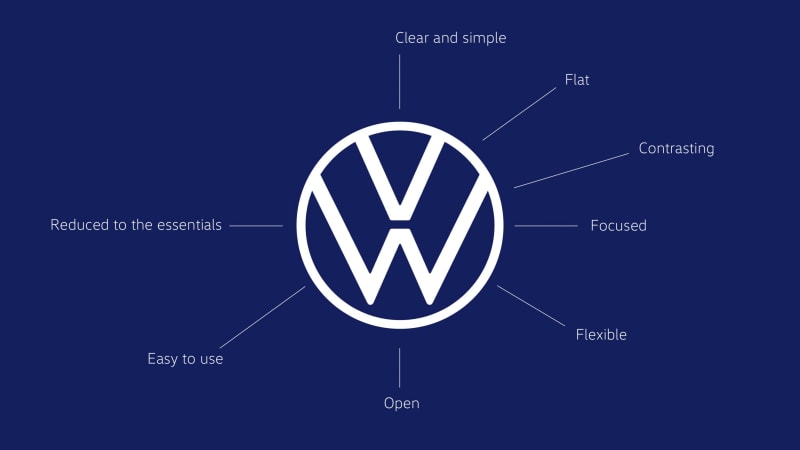Volkswagen’s clean, fresh logo
https://ift.tt/30rx4UI

At the Frankfurt Motor Show last week Volkswagen officially showed the world that it, as a brand, is now a different company than it was just a few years ago, that it is, in the company’s words, pursing a “future that is electric, fully connected and has a neutral carbon balance.” Which is a lot of weight for a car, the ID.3, as well as a platform, the MEB, to carry.
But they’re not carrying them alone. According to Volkswagen, it is now the “New Volkswagen,” and it has the logo to prove it.
The “Old Volkswagen,” of course, is the company that had diesel fuel — or perhaps that would be better put as “diesel exhaust” — sullying the brand.
If we turn back the clock to the mid-2000s, the company was working to convince U.S. buyers that its EA189 TDI engines were “Clean Diesel,” not the smelly, oily, dirty things that many Americans had associated diesels with. And the marketing campaign worked rather well, with plenty of Passats and Jettas being sold, not only to people who thrive on the low-end torque that diesel engines provide, but to drivers who have an environmental bias and bought into the cleanliness of the diesel engine that Wolfsburg was providing.
Of course, as we all know, Volkswagen admitted in September 2015 the “Clean Diesel” really wasn’t, and there were some 580,000 “Clean Diesels” — and at this point the quotes become ironic — in the U.S. that were really rather dirty, speaking from a regulatory standpoint. Which, in the U.S., has led to fines and penalties as a result of a variety of lawsuits and actions against the company to the tune of $25 billion. What’s more, people are literally behind bars as a consequence of this over-effective marketing approach.
And this is just in the U.S. As information billowed out, governments around the world wanted their day in court with the German brand.
It was a global cloud that not only created financial repercussions for the brand, but undoubtedly made more people leery of what VW has on offer, especially those who thought they were being environmentally appropriate.
So what to do? Create electric cars.
And come up with a fresh logo.
The original V over a W in a circle goes back to 1939, although the circle then resembled a spur gear. There were changes through the years, with the emblem being pretty much the same, with black going to blue and the blue hue changing with time.
In 2000 a 3D-style badge was released. This can be considered an example of “skeuomorphic” design, with the 2D logo seeming to have an additional dimension.
But in 2013 Apple pretty much put an end to that approach to graphic design when it launched iOS 7, which has “flat” design elements. 2D is 2D.
While the company was undoubtedly preoccupied with other things that didn’t have to do with its logo, flat design has become seemingly de rigueur; VW is a little late to the party.
Announcing the new execution, Jürgen Stackmann, Member of the Brand Board of Management responsible for Sales, Marketing and After-Sales, explained, “By formulating new content and with new products, the brand is undergoing a fundamental transformation towards a future with a neutral emission balance for everyone. Now is the right time to make the new attitude of our brand visible to the outside world.”
And that brand needs a boost in the outside world. According to the respected annual Kantar Millward Brown BrandZ study of the top 100 most valuable brands in the world, VW doesn’t make it, although German competitors Mercedes (at 54) and BMW (at 55) do.
As does Toyota, at 41, which has a brand valuation of $29.15 billion, making it by far the most valuable automotive brand in the world. What is VW’s valuation in the study? $6.7 billion. To put that in context, realize that Subway — as in the sandwich emporium — is more than twice as valuable $17.12 billion).
In addition to the logo, VW is looking at all graphic elements of its communication systems and modifying them so as to make them appropriate for viewing on digital media.
The first place where the logo is evident is at Wolfsburg HQ.
Then facilities and dealerships in Europe and China this year, and the rest of the world, including the U.S., in 2020. VW calculates that there will be about 70,000 logos replaced.
Explaining the approach, VW chief designer Klaus Bischoff explained, “In the new brand design, we have created an authentic communications platform for the emotional presentation of e-mobility. We are showing the Volkswagen of the future under the motto of ‘digital first’ and ‘no filter.’”
Arguably that last bit — that lack of a filter — got them into the mess they’re working themselves out of.
Auto Blog
via Autoblog https://ift.tt/1afPJWx
September 17, 2019 at 02:00PM
